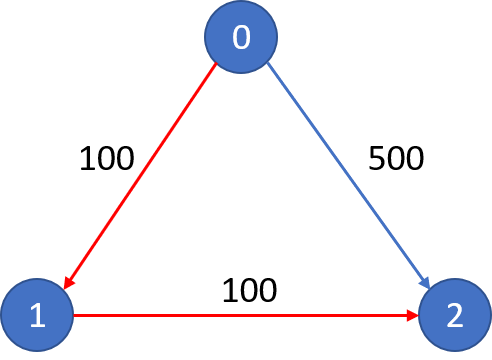[LeetCode] Network Delay Time 网络延迟时间——最短路算法 Bellman-Ford(DP) 和 dijkstra(本质上就是BFS的迭代变种) 动态规划,要会模板!
https://leetcode.com/problems/network-delay-time/
There are N network nodes, labelled 1 to N.
Given times, a list of travel times as directed edges times[i] = (u, v, w), where u is the source node, v is the target node, and w is the time it takes for a signal to travel from source to target.
Now, we send a signal from a certain node K. How long will it take for all nodes to receive the signal? If it is impossible, return -1.
Note:
Nwill be in the range[1, 100].Kwill be in the range[1, N].- The length of
timeswill be in the range[1, 6000]. - All edges
times[i] = (u, v, w)will have1 <= u, v <= Nand1 <= w <= 100.
这道题给了我们一些有向边,又给了一个结点K,问至少需要多少时间才能从K到达任何一个结点。这实际上是一个有向图求最短路径的问题,我们求出K点到每一个点到最短路径,然后取其中最大的一个就是需要的时间了。
可以想成从结点K开始有水流向周围扩散,当水流到达最远的一个结点时,那么其他所有的结点一定已经流过水了。最短路径的常用解法有迪杰克斯特拉算法Dijkstra Algorithm, 弗洛伊德算法Floyd-Warshall Algorithm, 和贝尔曼福特算法Bellman-Ford Algorithm,其中,Floyd算法是多源最短路径,即求任意点到任意点到最短路径,而Dijkstra算法和Bellman-Ford算法是单源最短路径,即单个点到任意点到最短路径。这里因为起点只有一个K,所以使用单源最短路径就行了。这三种算法还有一点不同,就是Dijkstra算法处理有向权重图时,权重必须为正,而另外两种可以处理负权重有向图,但是不能出现负环,所谓负环,就是权重均为负的环。为啥呢,这里要先引入松弛操作Relaxtion,这是这三个算法的核心思想,当有对边 (u, v) 是结点u到结点v,如果 dist(v) > dist(u) + w(u, v),那么 dist(v) 就可以被更新,这是所有这些的算法的核心操作。Dijkstra算法是以起点为中心,向外层层扩展,直到扩展到终点为止。根据这特性,用BFS来实现时再好不过了。
1 2 3 4 5 6 7 8 9 10 11 12 13 14 15 16 17 | class Solution(object): def networkDelayTime(self, times, N, K): """ :type times: List[List[int]] :type N: int :type K: int :rtype: int """ inf = float('inf') dp = [inf]*(N+1) dp[K] = 0 for i in range(1, N): # N+1 is not neccessary for u,v,w in times: #if v == i: dp[v] = min(dp[v], dp[u]+w) max_d = max(dp[1:]) return -1 if max_d == inf else max_d |
注意:(1) 我以为是要加一个if判断,实际上是错的。迭代是针对图里所有边,第一次迭代找到的是source点走一次直接连接的最短路。第二次是走二次的最短路迭代。一直到第n-1次走的最短路。
(2)为啥是1,N而不是N+1。
为什么要循环n-1次?图有n个点,又不能有回路,所以最短路径最多n-1边。又因为每次循环,至少relax一边所以最多n-1次就行了!
dijkstra解法:
1 2 3 4 5 6 7 8 9 10 11 12 13 14 15 16 17 18 19 20 21 22 23 24 25 26 27 28 29 30 31 32 | class Solution(object): def networkDelayTime(self, times, N, K): """ :type times: List[List[int]] :type N: int :type K: int :rtype: int """ return self.dijkstra(times, N, K) def dijkstra(sefl, times, N, k): G = collections.defaultdict(dict) for n1, n2, w in times: G[n1][n2] = w inf = float('inf') dist = {node:inf for node in range(1, N+1)} dist[k] = 0 nodes = set(range(1, N+1)) while nodes: node = min(nodes, key=dist.get) # update dist for n in G[node]: dist[n] = min(dist[n], dist[node] + G[node][n]) # node visited nodes.remove(node) max_dist = -1 for node in dist: if node != k: max_dist = max(max_dist, dist[node]) return max_dist if max_dist != inf else -1 |
或者将dist数据结构修改为list
1 2 3 4 5 6 7 8 9 10 11 12 13 14 15 16 17 18 19 20 21 22 23 24 25 26 27 28 29 | class Solution(object): def networkDelayTime(self, times, N, K): """ :type times: List[List[int]] :type N: int :type K: int :rtype: int """ return self.dijkstra(times, N, K) def dijkstra(sefl, times, N, k): G = collections.defaultdict(dict) for n1, n2, w in times: G[n1][n2] = w inf = float('inf') dist = [inf]*(N+1) dist[k] = 0 nodes = set(range(1, N+1)) while nodes: node = min(nodes, key=dist.__getitem__) # update dist for n in G[node]: dist[n] = min(dist[n], dist[node] + G[node][n]) # node visited nodes.remove(node) max_dist = max(dist[1:]) return max_dist if max_dist != inf else -1 |
==》dj的见bfs模板,上面自己写的不优雅!
787. K 站中转内最便宜的航班
有 n 个城市通过一些航班连接。给你一个数组 flights ,其中 flights[i] = [fromi, toi, pricei] ,表示该航班都从城市 fromi 开始,以价格 pricei 抵达 toi。
现在给定所有的城市和航班,以及出发城市 src 和目的地 dst,你的任务是找到出一条最多经过 k 站中转的路线,使得从 src 到 dst 的 价格最便宜 ,并返回该价格。 如果不存在这样的路线,则输出 -1。
示例 1:
输入: n = 3, edges = [[0,1,100],[1,2,100],[0,2,500]] src = 0, dst = 2, k = 1 输出: 200 解释: 城市航班图如下

从城市 0 到城市 2 在 1 站中转以内的最便宜价格是 200,如图中红色所示。
示例 2:
输入: n = 3, edges = [[0,1,100],[1,2,100],[0,2,500]] src = 0, dst = 2, k = 0 输出: 500 解释: 城市航班图如下

从城市 0 到城市 2 在 0 站中转以内的最便宜价格是 500,如图中蓝色所示。
解题思路见:https://leetcode.cn/problems/cheapest-flights-within-k-stops/solution/k-zhan-zhong-zhuan-nei-zui-bian-yi-de-ha-abzi/
本质上 就是Bellman-Ford(DP) ,
1 2 3 4 5 6 7 8 9 10 11 12 13 14 15 | from collections import defaultdictfrom heapq import heappush, heappopclass Solution: def findCheapestPrice(self, n: int, flights: List[List[int]], src: int, dst: int, k: int) -> int: pre = [float("inf")] * n pre[src] = 0 for _ in range(k + 1): cur = pre[:] for i, j, p in flights: if pre[i] + p < cur[j]: cur[j] = pre[i] + p pre = cur[:] return pre[dst] if pre[dst] < float("inf") else -1 |





【推荐】国内首个AI IDE,深度理解中文开发场景,立即下载体验Trae
【推荐】编程新体验,更懂你的AI,立即体验豆包MarsCode编程助手
【推荐】抖音旗下AI助手豆包,你的智能百科全书,全免费不限次数
【推荐】轻量又高性能的 SSH 工具 IShell:AI 加持,快人一步
· 记一次.NET内存居高不下排查解决与启示
· 探究高空视频全景AR技术的实现原理
· 理解Rust引用及其生命周期标识(上)
· 浏览器原生「磁吸」效果!Anchor Positioning 锚点定位神器解析
· 没有源码,如何修改代码逻辑?
· 全程不用写代码,我用AI程序员写了一个飞机大战
· MongoDB 8.0这个新功能碉堡了,比商业数据库还牛
· 记一次.NET内存居高不下排查解决与启示
· 白话解读 Dapr 1.15:你的「微服务管家」又秀新绝活了
· DeepSeek 开源周回顾「GitHub 热点速览」
2016-12-09 英语中逗号作用
2016-12-09 splunk LB和scale(根本在于分布式扩展index,search)
2016-12-09 Splunk Enterprise architecture——转发器本质上是日志收集client附加负载均衡,indexer是分布式索引,外加一个集中式管理协调的中心节点
2016-12-09 c中gets函数使用可能导致缓冲区溢出
2016-12-09 日志易——中国版的splunk